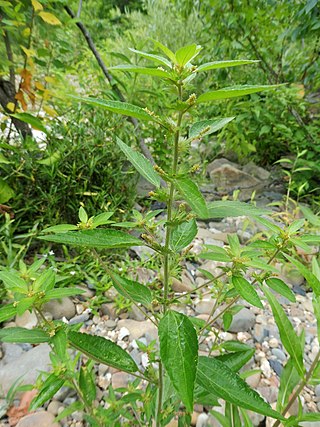
Potamogeton is a genus of aquatic, mostly freshwater, plants of the family Potamogetonaceae. Most are known by the common name pondweed, although many unrelated plants may be called pondweed, such as Canadian pondweed. The genus name means "river neighbor", originating from the Greek potamos (river) and geiton (neighbor).

Trillium rugelii is a species of flowering plant in the family Melanthiaceae. It is endemic to the southeastern United States. Its white flower is typically found nodding beneath the leaves, hence it is known as the southern nodding trillium. The specific epithet rugelii honors Ferdinand Rugel, a botanist and plant collector who collected plant specimens throughout the southeastern U.S. during the period 1840–1848. Although the species is apparently secure across its range, statewide it is vulnerable at best.

Trillium vaseyi is a species of flowering plant in the family Melanthiaceae. It is a spring-flowering perennial plant found only in the southeastern United States. The specific epithet vaseyi honors the American plant collector George Richard Vasey, not to be confused with his father George S. Vasey. The species is commonly called Vasey's Trillium. It is also known as the sweet wakerobin, sweet trillium, or sweet beth.

George S. Vasey was an English-born American physician and botanist. He practiced medicine in Illinois for nearly two decades. He was appointed Chief Botanist at the United States Department of Agriculture in 1872, a position he held for the remainder of his life. His greatest achievement was the building up of the United States National Herbarium.
Eryngium vaseyi is a species of flowering plant in the family Apiaceae. It is endemic to California. The specific epithet vaseyi honors the American plant collector George Richard Vasey who made extensive collections in the region in 1880 and 1881. The species is commonly called Vasey's coyote-thistle.

Vaseyochloa is a monotypic genus in the grass family Poaceae. Its sole species, the flowering plant Vaseyochloa multinervosa, is endemic to Texas. It is commonly known as Texasgrass.

Potamogeton alpinus is a species of perennial aquatic plant known by the common names alpine pondweed and red pondweed. It is widespread in the northern hemisphere in both rivers and lakes with good water quality.

Salvia vaseyi, the scallop-leaf sage, bristle sage or wand sage, is a perennial native to the western Colorado Desert. The specific epithet vaseyi honors the American plant collector George Richard Vasey, not to be confused with his father George S. Vasey.

Rhododendron vaseyi, the pinkshell azalea, is a species of flowering plant in the heath family Ericaceae. It is endemic to the Appalachian highlands of North Carolina. The specific epithet vaseyi honors the American plant collector George Richard Vasey and his father Dr. George Vasey, Chief Botanist at the United States Department of Agriculture from 1872 to 1893. The species is sometimes referred to as the Vasey Rhododendron.

Solidago ptarmicoides, the prairie goldenrod, white flat-top goldenrod or upland white aster, is a North American perennial flowering plant in the family Asteraceae. It is native to the central and eastern Canada and parts of the United States (mostly Great Lakes region, the Northeast, the Ozarks, and the northern Great Plains, with isolated populations in Wyoming, Colorado, Oklahoma, and scattered locations in the Southeast. It has also been called upland white solidago, upland white goldenrod, and sneezewort goldenrod
Malaxis bayardii, or Bayard's adder's-mouth orchid, is a species of orchid native to northeastern North America. It is found from Massachusetts to North Carolina, with isolated populations in Ohio and Nova Scotia. There are historical reports of the plant formerly growing in Vermont and New Jersey, but it seems to have been extirpated in those two states It grows in dry, open woods and pine barrens at elevations of less than 600 m.

Potamogeton berchtoldii, common name small pondweed, is an aquatic plant.

Bidens eatonii is a North American species of flowering plant in the family Asteraceae. It is native to eastern Canada and the northeastern United States.

Chrysothamnus vaseyi is a species of flowering plant in tribe Astereae in the daisy family Asteraceae. It is native to the Southwestern United States. The specific epithet vaseyi honors the American botanist George S. Vasey. The species is commonly called Vasey's rabbitbrush.

Solidago latissimifolia, common name Elliott's goldenrod, is North American species of flowering plants in the family Asteraceae. It is native to the Atlantic Coast of the United States and Canada, from Nova Scotia south to Alabama and Florida.
Hymenoxys vaseyi is a species of flowering plant in the daisy family Asteraceae. It is native to the Southwestern United States. The specific epithet vaseyi honors the American plant collector George Richard Vasey who made extensive collections in the region in 1880 and 1881. The species is commonly called Vasey's rubberweed.

Quercus vaseyana is a species of tree in the beech family Fagaceae. It is native to northern Mexico and the U.S. state of Texas. The specific epithet vaseyana honors the American botanist George S. Vasey. The species is commonly called the Vasey oak.

Acalypha virginica, commonly called Virginia threeseed mercury or Virginia copperleaf, is a plant in the spurge family (Euphorbiaceae). It is native to the eastern United States. It is found in a variety of natural habitats, particularly in open woodlands and along riverbanks. It is a somewhat weedy species that responds positively to ecological disturbance, and can be found in degraded habitats such as agricultural fields.
George Richard Vasey (1853–1921) was an American plant collector who collected in at least eight U.S. states including California, North Carolina, and Washington. He was the son of Dr. George S. Vasey, a physician and botanist. The botanical activities of father and son overlapped in time, so the two men are often confused.
Juncus vaseyi is a species of flowering plant in the rush family Juncaceae. It is native to North America. The specific epithet vaseyi honors the American botanist George S. Vasey. The species is commonly called Vasey's rush.
















